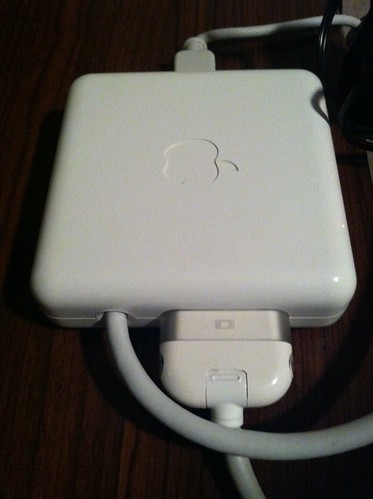An Old School Apple Cinema Display Revival
Amidst the hoopla of this year’s World Wide Developer’s Conference, the biggest event I was looking forward to this week was the delivery of a piece of technology invented nearly 5 years ago, for a display that is nearly 10 years old.
The Apple ADC to DVI Adapter
I’m speaking of the Apple ADC to DVI adapter, of course. It’s a rare, but expensive, commodity these days – commanding quite a bit of money on Amazon and eBay (anywhere from $104 on up). The Apple ADC to DVI adapter (ADC/DVI from here on out) was meant to allow any ADC-equipped Apple Cinema Display to work with DVI-based video cards.
My Cinema Display Experience
I purchased an Apple Cinema Display (20″) brand new in 2003 along with my PowerMac G5. It was my first LCD display. I fell in love with the screen quality and brightness, not realizing that Apple’s decision to go with a proprietary connector (that combined video, power, and USB into one cable) would bite me hard a few years later.
The Cinema Display itself served me well for many years, but eventually developed the nefarious “3 blink / dim LCD” problem. It was sent back and forth to Apple’s repair center while it was under AppleCare. After AppleCare ran out, I opened up the display and replaced a faulty inverter.
From 2010 on up, the Cinema Display was hooked up to the venerable PowerMac G5 that my daughter would use ever so sporadically. (She’s not at all interested in using computers; she prefers to dominate her father’s iPad instead.)
A Clear and Present Danger
Fast-forward to a few months ago. I packed up the G5 and Cinema Display and put them in a closet. (This is, after all, where most obsolete tech makes their home, until the inevitable “trash / recycle day” takes place.) Out of sight, out of mind, right?
Wrong.
Aarti wanted to know what I planned to do with the Cinema Display. This is my wife’s way of telling me that if I wasn’t going to use it, I needed to get rid of it.
The Discovery
Aarti’s ultimatum was just the motivation I needed to find out whether the Cinema Display itself was, in fact, salvageable. (Wives are great like that, aren’t they?) ;)
And that’s when I discovered that there was, in fact, such a thing as an ADC to DVI adapter, made by Apple no less. Armed with information, I started scouring the net to find one of these mythical adapters.
My search across eBay and Amazon wasn’t promising, mostly because of the asking prices. The going rate of the ADC/DVI was $109 for used versions. all the way up to $280 for one “new-in-box”. For $200 I could buy a decently spec’d brand new display.
I was just about to give up and bail on my Cinema Display when I came across a used ADC/DVI adapter selling for $58 at PowerMax, an Oregon-based company specializing in selling new and used Macs. (BTW, I have nothing but great things to say about the company – a real person replied after I placed my order, and kept me informed when the adapter shipped! In an era of auto-confirmation e-mails, PowerMax really stood out with their personalized and friendly customer service.)
The price was right. But in the back of my mind, I had my concerns. What if the ADC/DVI connector didn’t work? (It was, after all, used.) What if my Cinema Display still has that dimming issue? How cheap am I, really?
Credit card in hand, I placed my order.
The Box
Less than a week later, I received a well-packed box from PowerMax. Inside the peanut-packed cardboard box was a smaller box, with the ADC/DVI nestled inside bubble-wrap.
I inspected the adapter – it was in really good condition. It could have passed for new, I suppose.
One side of the adapter connects to AC power, while the other has an ADC connector built in. The ADC/DVI has a third wire that splits into two – one fork contains the DVI cable while the other has USB.
I plugged the Cinema Display into the ADC/DVI adapter and plugged the DVI / USB cable into the Mac Pro. Finally, I plugged the unit into my APC Uninterruptible Power Supply (UPS).
She’s Alive!
I crossed my fingers and powered the Mac on. Within a few milliseconds I was staring at the Apple logo on the Cinema Display. The Power indicator on the display was solid (not blinking), and the backlight was uniformly lit. My Cinema Display worked!
I really wanted to see if the blinking / dimming problem I had experienced a few years ago was finally fixed, so I tested the Cinema Display by putting the Mac Pro to sleep. Waking the Mac back up, the Cinema Display behaved normally, holding its brightness and clarity. So far, so good!
Moving up to the 20″ Cinema Display from my 19″ Hanns-G monitor was a nice step-up for me. I felt a little confined with the smaller size. With the Cinema Display, I have more screen real-estate to work with on my Mac (1680 x 1050 versus 1280 x 960). As a bonus, I also have access to two extra USB ports that are behind the Cinema Display.
Conclusion
For a mere $58, I was able to revive a perfectly good display that would have otherwise been relegated to the scrap heap. I have a bigger, brighter and better display to work with now, and two extra USB ports. Plus, I discovered another great company, PowerMax, in the process. Win-win-win!
If only recycling other stuff was this easy…
-Krishna
Update:
I was a bit presumptuous – the Cinema Display has started exhibiting the blinking / dimming problem once again. Most likely it’s a bad inverter board… *sigh*
Update 2:
Unplugging the ADC cable from the adapter after turning the Mac Pro off, then restarting the computer, once again restored the brightness of my display. I’m thinking that the issue might stem from when the Mac Pro is set to go to sleep…
Update 3:
I’ve turned off the “Set to Display” sleep option for both monitors and plan to test it for a week to see if “sleeping” does something to cause the dimming. I’ll report back soon.
Final update:
The Cinema Display backlight works beautifully as long as it is not put to sleep.







TonyJ
June 13, 2012 at 3:55 amHi Krishna,
If your wife is anything like mine, then I think your final line should actually have been;
“Aarti now wanted to know what I planned to do with the 19″ Hanns-G monitor.” ;-)
Krishna
June 13, 2012 at 6:32 pmlol – you’re right on the money, Tony. So far, she hasn’t asked, but that’s because I’m using the extra DVI display as a second screen for my Macbook Pro. ;)
Madscott
June 14, 2012 at 9:47 amThe rule of thumb is that it’s not junk as long as it looks like it’s in use. I have old laptops like this.
Krishna
June 14, 2012 at 9:48 amVery true, Scott!